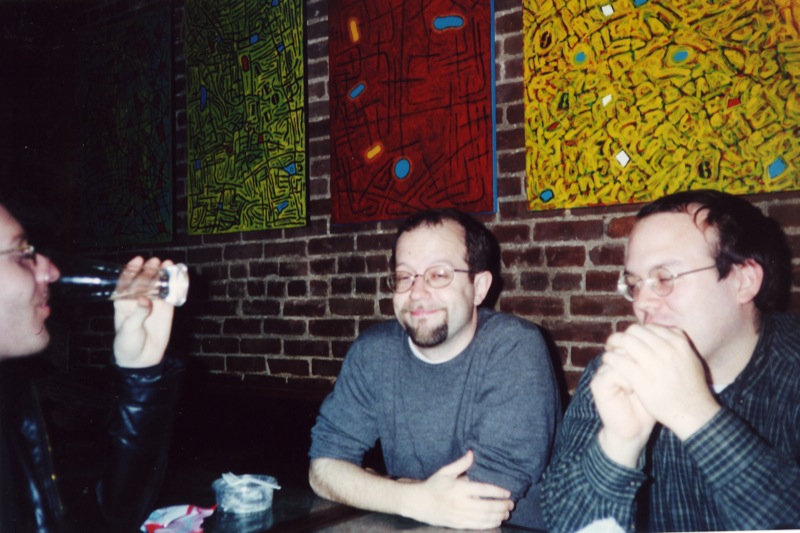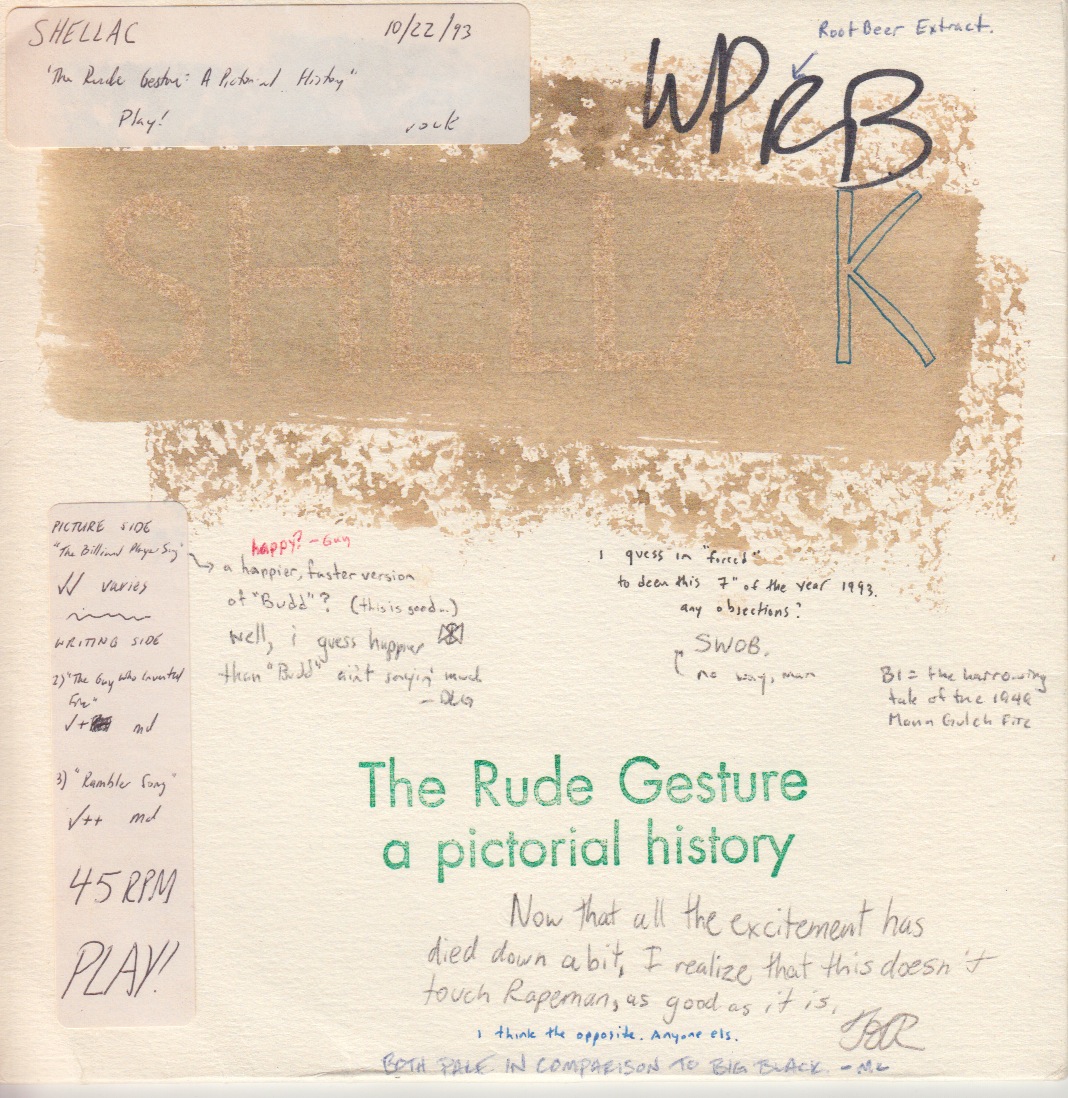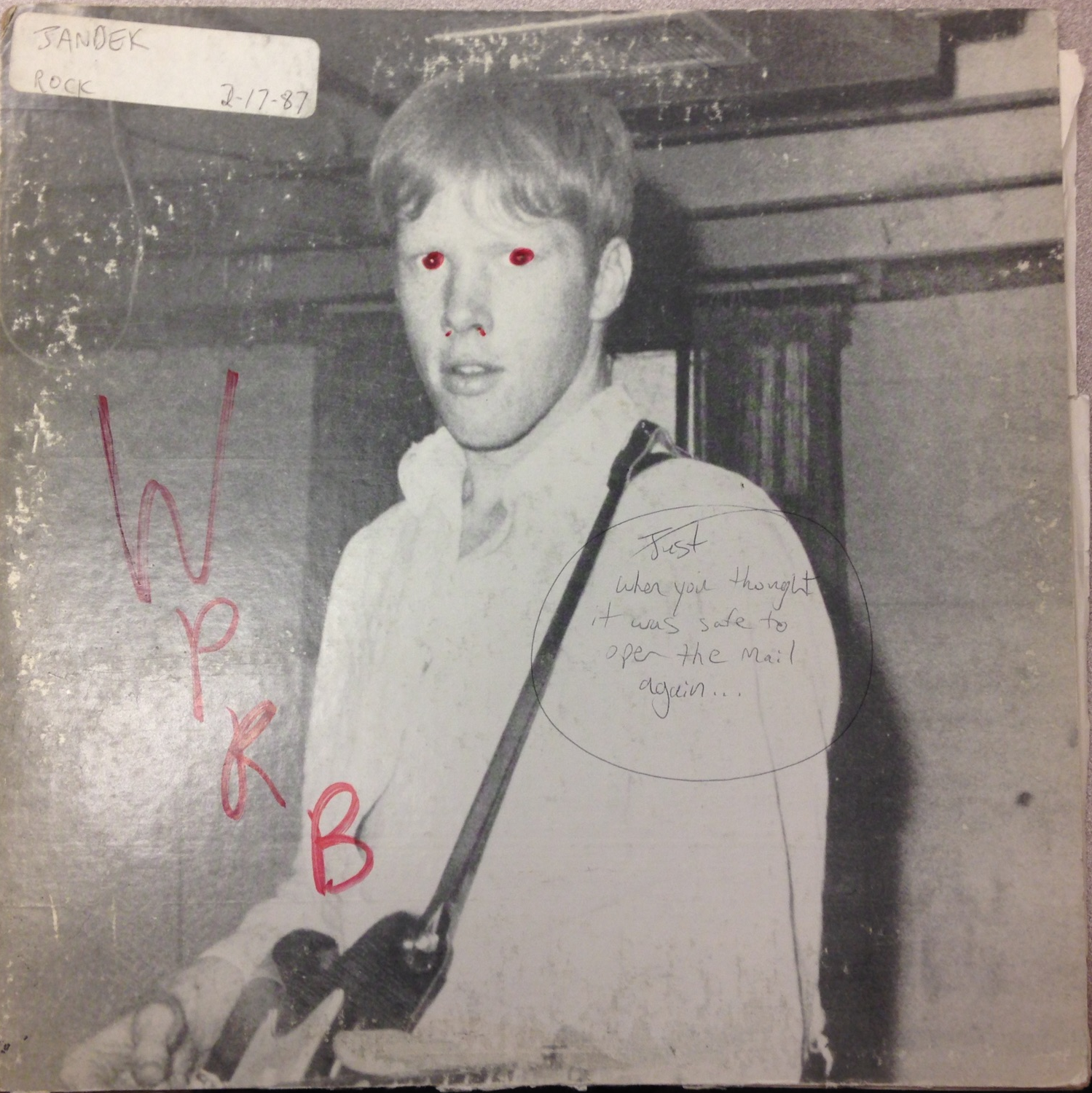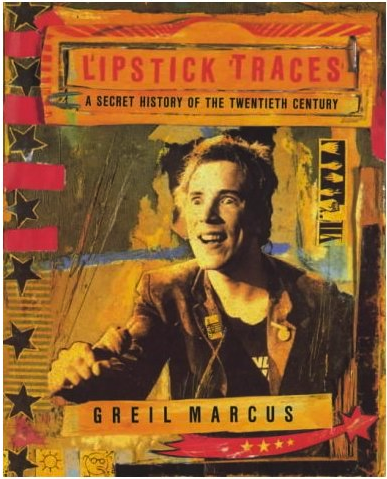“All those records—Who knew what they might hold?”

By Matthew H. Robb ’94 (center, looking skeptical at Maxwell’s, Hoboken, NJ)
DJ from 1991-1997; 1999-2000
Jazz Director ’92; Program Director ’93
Also pictured above: Greg Lyon (left), Evan Bates (right)
I’ve been thinking about this for a few weeks now and it’s funny to me how non-specific most of my WPRB memories are. There are definitely some concrete ones – I’m pretty sure I was in the old studio A / aux sorting records when the on-air DJ, who I am confident was Scott Crater, put on Superchunk’s Cool 7” and that just pretty much changed my life. It somehow coalesced everything I knew about music (well, alternative and punk music) up until that point and blew it wide open. But maybe that’s getting ahead of things.
I knew a little about radio when I was high school, volunteering at the local public radio station, and I was was of those alternative music teenagers—lots of New Order, the Cure, etc. Add to that an older brother whose tastes ran to the Jam, Elvis Costello, the Clash, and the Replacements, and growing up in the south with a certain familiarity with the Athens scene. I was definitely a pop kid more than a punk kid – the glasses made going to hardcore shows a little nerve-wracking when I was in high school, and the punk scene in north Alabama felt a little too aggro for me. So Josh Wise and I would listen to a lot of Pixies and REM and trade notes and records. That mixtape culture, way too may VHS recordings of 120 Minutes and IRS’ the Cutting Edge – that’s what I had when I walked into my first DJ training sessions (with Mike Graff, I believe). And seeing those stacks I started to realize how little I knew.
All those records – who knew what they might hold? It was intimidating, because you knew you could never listen to them all. So you pull something out, almost at random, or a record so played out the sleeve was falling apart, preview a couple of tracks and read the guiding hand of the review – that was how I learned to trace some kind of lineage through the station’s history – handwriting, initials, ratings – and how that lineage overlapped and included musical ones. Who got to review a record like Reckoning? If I had to pick one band that I didn’t really know before that somehow explained everything, I’d pick the Feelies. I don’t remember exactly how or when I figured out that they were pretty much required listening, like a genetic template for just about everything WPRB played. Of course as soon as I type that I think of other bands with similar legendary status – the Clean, Mission of Burma, Television, Galaxie 500. Learning how to review records – learning how to modulate my twee enthusiasm such that a more punk-oriented DJ might consider spinning something, understanding that a check-check / double-check song really better be in that pantheon of indisputable greats (like, say, Shellac’s “Billiard Player’s Song”) – that was the art of it.

There was a certain amount of dues-paying: graveyard shifts, mail-getting, crappy record listening, all that stuff. But the amount of freedom we had was astonishing. So it was easy to think about spending even more time there, despite the persistent damp. The board meetings were a well-known tedium factor, but the trustees were all pretty cool about things and in retrospect it was like parents giving us the keys to an extremely expensive and valuable car and praying that we didn’t wreck it. This was right around the time the signal got boosted and it became pretty apparent that being at 103.3 was kind of a big deal. On a good day you could get the station in lower Manhattan.
I coveted that key to [WPRB’s studio in] Holder Hall—SB64—and must have gotten one around the time I started as jazz director. I did that because it was a faster way to get on the air at a reasonable hour and because holy shit those opening notes on Sonny Clark’s “Cool Struttin’” – what the hell was that? I had never heard anything like it. Or Superchunk for that matter. Or, later in the 90s, the kind of Alvin Lucier experimental stuff that John Monroe would play on his show.
The time frame I remember most vividly was that fall of 91 – Spring of 92 phase. Nirvana’s Nevermind had come out and became a little like an elephant in the room. There was no one who denied that it was a great record, but once it was out there and huge it really wasn’t necessary to play it any more. And then there was this rush of interest on the part of other major labels to find The Next Big Thing. So it was fun, feeling like we might have a say in how that happened. Sean Murphy went to the Lotsapopolosers fest in DC sponsored by Simple Machines, Teen Beat, and Slumberland Records and all the music he brought back essentially laid the foundation for everything I listened to for the next fifteen years.
The ways records would just infect us – I remember the sudden addiction many of us had for Pavement’s “Debris Slide” in the summer of ’91, when a number of us were living in [Princeton University dormatory] Spelman and driving back and forth to the Stop and Shop on Route 1 (…radio on!) I remember driving down Washington Road on one of those perfect spring days with Unrest’s “I Do Believe You are Blushing” blasting out the windows. Things like that.
So much of it was about timing – getting the segue right, building the mix, having a plan but being willing to improv – from the regular shows to dropping in the ABC news feed at exactly the right minute (and patiently waiting for the astonishingly repetitive ads – “S-O-C. K S?” is ingrained in my mind as a weirdly maladaptive way of learning Spanish). Or developing a finely-honed connoisseurship of what Sean began calling “post-apocalypse rock” – things like the Dead C, mostly. I remember going down the steps of [Holder Hall’s] 11th entryway one day to do my show and having the skies be this roiling green that you get right before a big storm and I put together this stream of [The Dead C’s] Trapdoor Fucking Exit or something like that and having someone call in saying they had just had this incredible experience driving on the NJ Turnpike with this lightning and rain breaking out all around them and on their car radio this…. sound. That was a good one. That and the Shopwell record. Is that even still around? [Ed. Yep!] Or the time Sean and I were on the trail of Jandek? And someone called from Corwood Industries?

So it was like that, stumbling onto these veins of weirdness and greatness, and then trying to shape it into an experience. Driving back from Maxwell’s watching the lights and plumes in Elizabeth, listening to Stephen Jesse Bernstein – it was out of something like Tony Smith’s vision of the New Jersey Turnpike (even though I wouldn’t read that essay for a few years yet). Having a flash, listening to the ABC audio for the umpteenth time and then running over to studio B to capture the raw feed of Ronald Reagan when he was assaulted on stage while receiving an award in 1992, and turning that into the Sound of Reagan’s Mind station ID.
LISTEN: “The Sound of Reagan’s Mind” WPRB Station ID
Not going to lie, I spent enough time in that basement to go more than a little stir crazy. Those goddamned ABC ads. The epic frustration of the program for tracking ads. Cajoling people into doing their shifts, and occasionally racing to the station to keep it on the air. How we managed that without cell phones I have no idea, but since we were usually at home, or at the Terrace Club, or at the Nassau Weekly offices, or at the station already, it usually worked out. When I was Program Director and told my parents I was going to have to stay in Princeton for the holidays to keep the station on the air, there was a bit of a family tizzy. This must have been 1993 or so – I remember that because Small World Coffee has just opened, and I went there to get a coffee fix while doing morning classical shows (Mahler – lots of Mahler). Anyway, there was a lot of concern on my family’s part about what would happen on Christmas Day. This must have been about five years into Jon Solomon’s holiday show. I don’t remember if Jon and I talked about it but I don’t remember being worried at all – that was 24 hours I knew that he had covered. That’s how Jon saved the Robb Family’s Christmas.
And the shows – after Sean went to that festival in DC in the fall of 91, there was a similar one in Providence that we went to with Mike Applestein (who I give credit for introducing us to Young Marble Giants), with a lot of the same bands – that synchronicity, knowing exactly what the breaks were in Small Factory’s “Suggestions” or Velocity Girl’s “My Forgotten Favorite” – unmatched, a room full of music nerds and art school punks all pogoing like mad. Versus, Unrest, Tsunami, Superchunk – eventually it got to the point where I had seen them all over the eastern seaboard. I saw Versus open for Tsunami at the old DC Space I think, late in ’91 right before it closed, and was completely blown away. They had a demo that I wore out, but not before I carted “Cross the Street” – and it charted, before they even had a single.
I’ve been playing a lot of that old school early 90s stuff, the singles you can find anywhere now, and many hold up pretty well. We were so lucky – that time frame was when labels like Merge were still just getting started, and we’d lap up anything some labels put out. I remember a string of Too Pure releases – Stereolab’s first record, PJ Harvey’s first record, th’ Faith Healer’s first LP, all astonishingly great. Getting some of those records both personally and for the station took a little doing, but if you showed up consistently at gigs and bought entire catalogues, got the music directors on the phone with them, labels did eventually start sending stuff on the regular. We had the re-rock trips to Pier Platters and we’d see some of the faces from the record shops at the shows too.

Those communities meant a lot – we had a little circuit of DJs and Terrace members, so we could reliably try to hook bands up with a gig or a couch between New York and Philly. Most of them thought it was pretty great. I got to be pretty good friends with Versus and Tsunami, got to see Bricks practice for the first time in a few years before playing at the working holiday party for Simple Machines. I remember Jon Spencer Blues Explosion at Campus Club, Superchunk and Guided by Voices at lawn parties, organizing an official WPRB show with Corndolly and I think Slow Loris, getting completely high while Stereolab did a soundcheck, an epic Quintron show, Eggs at Terrace one night, playing in togas, coming in with candles, singing what I think was also on a Sisterhood of Convoluted Thinkers single, and playing a great set that included an epic, drunken cover of “Baba O’Riley”.
Covers were pretty critical, actually, and like those record reviews a stamp of approval from a much loved band could open up whole other avenues. I stumbled across a 1984 Springsteen tribute LP – Springsteen was not cool at the time, but it had a favorite 80s Austin band of mine, the Reivers, doing “Atlantic City,” which made Springsteen newly appealing. Hearing Nebraska for the first time, really, at more or less the same moment that Will Oldham started churning out Palace records – things started to click in different ways. Or think of all those Galaxie 500 covers. I practically wept at Ida playing Neil Young’s “Sail Away”, and their cover of “Pink Moon” sent me down a Nick Drake rabbit hole for a nice long while, and I vividly remember sitting at Elliot Smith’s feet when he played “Waterloo Sunset” at Terrace. Each of these opened up a whole new avenue of things I’d never heard before or just hadn’t listened to enough, apparently.
That was probably after I had graduated. I was really lucky that I got to stick around Princeton and WPRB for a few years on and off, and did a couple of co-hosting shows with John Clements and then later with Betsy Stoel. They kept me honest and didn’t let me play the same early 90s stuff over and over again. Once, somewhere in this late time frame, I was sitting in the lobby with some younger summer volunteers, trading some music stories and we got around to talking about the first records we ever bought. I have two that I point to that explain a lot – the Pretenders’ Learning to Crawl and Sports (no, I’m not even going to name the band). One of these kids said Nevermind. That was when I started to realize that deeper history of how things get passed on, and how crucial a place like WPRB was in preserving these episodes in the history of taste. So in 2015, My Aim is True is as distant for a 20-year old today as something like the Chess and Sun record labels were for me in 1992. That was about the time I first read Lipstick Traces, too – trying to understand these patterns of consumption as more than just cultural postures.

So that’s my little slice of the pie. I’m sure I’ve muddled the chronology, but I hope it helps explain something of what it was like at that point, how we found out about things, promoted some, jealously guarded others, and shared what we thought was great or weird or just plain fun. To Sean, to Jon Solomon, Mike Lupica, Jen Moyse, Corey Magnell, Rebecca Irwin, Scott Crater, Dave Mills, Bryan McCann, Dan Gabbe, Christian Perring, Arthur Fenno, Hugh Hynes, Martha Hurley, Greg Lyon, Melissa Ho, Adam Rosen, Paul Henninger, Justin Goh, Josh Wise, Matthew Brown, Wilbo, Zora O’Neil, Betsy Stoel, John Clements, John Monroe, Alex Gregory, Ken Katkin, Ethan Stein, among many others, anyone who ever subbed when I asked them to, anyone who ever let me behind the microphone, to all the board members and DJs that came before us and built a strong foundation, to all the classes that came after and all the undergraduates and the volunteers that seem to be keeping the place up to snuff, my deepest thanks. And to the bands, who were the reason in the first place.
